In vitro characterization of the enzyme properties of the phospholipid N-methyltransferase PmtA from Agrobacterium tumefaciens
- PMID: 19181804
- PMCID: PMC2655499
- DOI: 10.1128/JB.01591-08
In vitro characterization of the enzyme properties of the phospholipid N-methyltransferase PmtA from Agrobacterium tumefaciens
Abstract
Agrobacterium tumefaciens requires phosphatidylcholine (PC) in its membranes for plant infection. The phospholipid N-methyltransferase PmtA catalyzes all three transmethylation reactions of phosphatidylethanolamine (PE) to PC via the intermediates monomethylphosphatidylethanolamine (MMPE) and dimethylphosphatidylethanolamine (DMPE). The enzyme uses S-adenosylmethionine (SAM) as the methyl donor, converting it to S-adenosylhomocysteine (SAH). Little is known about the activity of bacterial Pmt enzymes, since PC biosynthesis in prokaryotes is rare. In this article, we present the purification and in vitro characterization of A. tumefaciens PmtA, which is a monomeric protein. It binds to PE, the intermediates MMPE and DMPE, the end product PC, and phosphatidylglycerol (PG) and phosphatidylinositol. Binding of the phospholipid substrates precedes binding of SAM. We used a coupled in vitro assay system to demonstrate the enzymatic activity of PmtA and to show that PmtA is inhibited by the end products PC and SAH and the antibiotic sinefungin. The presence of PG stimulates PmtA activity. Our study provides insights into the catalysis and control of a bacterial phospholipid N-methyltransferase.
Figures
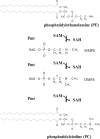


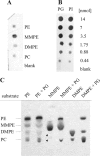
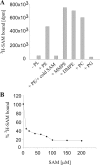
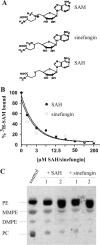
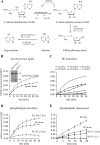
Similar articles
-
S-adenosylmethionine-binding properties of a bacterial phospholipid N-methyltransferase.J Bacteriol. 2011 Jul;193(14):3473-81. doi: 10.1128/JB.01539-10. Epub 2011 May 20. J Bacteriol. 2011. PMID: 21602340 Free PMC article.
-
Structural basis for phosphatidylcholine synthesis by bacterial phospholipid N-methyltransferases.J Biol Chem. 2025 May;301(5):108507. doi: 10.1016/j.jbc.2025.108507. Epub 2025 Apr 11. J Biol Chem. 2025. PMID: 40222548 Free PMC article.
-
Membrane lipids in Agrobacterium tumefaciens: biosynthetic pathways and importance for pathogenesis.Front Plant Sci. 2014 Mar 26;5:109. doi: 10.3389/fpls.2014.00109. eCollection 2014. Front Plant Sci. 2014. PMID: 24723930 Free PMC article. Review.
-
Membrane Remodeling by a Bacterial Phospholipid-Methylating Enzyme.mBio. 2017 Feb 14;8(1):e02082-16. doi: 10.1128/mBio.02082-16. mBio. 2017. PMID: 28196959 Free PMC article.
-
Phosphatidylcholine biosynthesis and function in bacteria.Biochim Biophys Acta. 2013 Mar;1831(3):503-13. doi: 10.1016/j.bbalip.2012.08.009. Epub 2012 Aug 19. Biochim Biophys Acta. 2013. PMID: 22922101 Review.
Cited by
-
Phospholipid N-Methyltransferases Produce Various Methylated Phosphatidylethanolamine Derivatives in Thermophilic Bacteria.Appl Environ Microbiol. 2021 Sep 10;87(19):e0110521. doi: 10.1128/AEM.01105-21. Epub 2021 Sep 10. Appl Environ Microbiol. 2021. PMID: 34288711 Free PMC article.
-
S-adenosylmethionine-binding properties of a bacterial phospholipid N-methyltransferase.J Bacteriol. 2011 Jul;193(14):3473-81. doi: 10.1128/JB.01539-10. Epub 2011 May 20. J Bacteriol. 2011. PMID: 21602340 Free PMC article.
-
Structural basis for phosphatidylcholine synthesis by bacterial phospholipid N-methyltransferases.J Biol Chem. 2025 May;301(5):108507. doi: 10.1016/j.jbc.2025.108507. Epub 2025 Apr 11. J Biol Chem. 2025. PMID: 40222548 Free PMC article.
-
Structural insights into phosphatidylethanolamine N-methyltransferase PmtA mediating bacterial phosphatidylcholine synthesis.Sci Adv. 2024 Oct 4;10(40):eadr0122. doi: 10.1126/sciadv.adr0122. Epub 2024 Oct 2. Sci Adv. 2024. PMID: 39356767 Free PMC article.
-
Membrane lipids in Agrobacterium tumefaciens: biosynthetic pathways and importance for pathogenesis.Front Plant Sci. 2014 Mar 26;5:109. doi: 10.3389/fpls.2014.00109. eCollection 2014. Front Plant Sci. 2014. PMID: 24723930 Free PMC article. Review.
References
-
- Arondel, V., C. Benning, and C. R. Somerville. 1993. Isolation and functional expression in Escherichia coli of a gene encoding phosphatidylethanolamine methyltransferase (EC 2.1.1.17) from Rhodobacter sphaeroides. J. Biol. Chem. 26816002-16008. - PubMed
-
- Bligh, E. G., and W. J. Dyer. 1959. A rapid method of total lipid extraction and purification. Can. J. Biochem. Physiol. 37911-917. - PubMed
-
- Carman, G. M., R. A. Deems, and E. A. Dennis. 1995. Lipid signaling enzymes and surface dilution kinetics. J. Biol. Chem. 27018711-18714. - PubMed
-
- Cho, W., and R. V. Stahelin. 2005. Membrane-protein interactions in cell signaling and membrane trafficking. Annu. Rev. Biophys. Biomol. Struct. 34119-151. - PubMed
Publication types
MeSH terms
Substances
LinkOut - more resources
Full Text Sources
Other Literature Sources
Molecular Biology Databases

